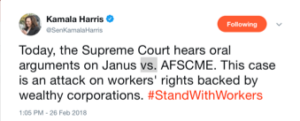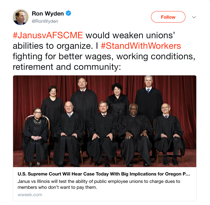Ten Tips for Talking About Janus v. AFSCME Council 31
On Feb 26, 2018, the United States Supreme Court heard oral arguments in Janus v. AFSCME Council 31, a case that will determine whether public sector unions that negotiate with employers over fair pay and work conditions may continue to receive fees from all employees who benefit from those advances. The inherent risk of this case is that if the Court sides with the plaintiff, then the freedom of working people to form unions will be greatly challenged. The outcome is critically important at a time when families face steep obstacles to economic security and mobility. The Janus case also has important implications for equity and civil rights, as unionized workplaces represent important pathways toward equal opportunity across racial, gender, and other identities. A decision in the Janus case could come at any time, but is expected near the end of the Supreme Court term in late June.
This memo offers advice on talking about the Janus case, with the goal of increasing awareness and support for the strong role of unions in securing greater and more equal opportunity for all. Whatever the outcome in Janus, we must push lawmakers to pursue all available avenues to strengthen the right of working people to organize through a union and demand fair treatment for everyone in our country’s workplaces.
Themes to Highlight:
1. Frame unions as being about our right to stick together. Research from Topos recommends framing the forming of unions as a right, thereby shifting the conversation to emphasize the people in them. They suggest the following message:
“Collective bargaining” means employees sticking together as a group so they speak with a more powerful voice. In order for employees to be heard, it’s often necessary to band together so companies take them seriously. And many employers try to prevent this so they can limit workers’ power.
2. Remind audiences how unions benefit all of us. It’s important to talk about how workers’ ability to organize and sustain unions benefits everyone – individuals, families, and whole communities. When union membership is high, entire workplaces and even regions enjoy wages that represent a fair return on work and greater social and economic mobility. The Economic Policy Institute documents this point here.
As researchers from Topos suggest, the story of who makes up unions is also important. In fact, today’s unions represent Americans from all backgrounds and walks of life: 46 percent of union members are women, 36 percent are people of color, 42 percent have a bachelor’s degree or higher, 40 percent work in education or health care, and 21 percent work in transportation, utilities and manufacturing.
3. Focus on shared values. Lead with the values you share with your audience, instead of with dry facts or rhetoric. Values to uplift include:
- Community: The strength of our nation springs from the unity of our diverse people. We are all in it together as Americans and as human beings. When we care about the progress of all members of our society, opportunity is no longer just about personal success but also about our success as a people.
- Economic security: We should all have the tools to meet our, and our families’, basic needs.
- Equal opportunity: Everyone deserves a fair shot at American ideals of prosperity and economic security. Unions increase fairness in the workplace, giving women and people of color a more equal chance to advance and contribute to their full potential.
- Our constitutional right to organize unions: We have the right to stick together and powerful interests want to strip us of that right.
4. Explain what unions do. Topos’ research found that one problem with increasing support for unions was that they seemed to be outside of the system, a provider of services. Remind people that unions are people who come together to amplify their voices for the good of all. Include a sentence or two to remind audiences why this is so important.
5. Talk about the need to balance our economic systems. Remember that most Americans agree that the economic system is unjust and imbalanced. Remind them that our economy should benefit everyone, not only the wealthiest corporations who are trying to dodge fair wages by stripping workers of their right to stick together. Unions provide a vehicle for individual workers to come together to correct that imbalance and push corporations toward greater economic opportunity for everyone. Note that the Janus case is part of a strategy by big corporations to further tilt the scales in their favor, and against everyday working people. Call on the Supreme Court, policymakers, and the public to reject political gain for some at the expense of economic opportunity for all.
6. Focus on real-world economic challenges. Almost everyone has experienced being unheard or feeling powerless in the work place – so use messages that uplift the point that unions help to address unjust working conditions and achieve better wages and benefits for everyone. When discussing the role of unions in creating more equal opportunity, document and explain the unequal obstacles facing women, people of color, low-wage workers and others.
7. Highlight systemic solutions to systemic problems. Use messages that discuss systemic problems and solutions, not individual responsibilities. For example, people in unions have come together time and time again to create solutions to the problems of corporate abuse and unfair working conditions. They serve as a space for all workers to address injustices in their work environment. These systems and the unions that create them are critical to the gains that have been made for all working people in our society. This means that unions have a positive impact on not only their members, but also on entire workplaces, industries and sectors that include union members and non-union members alike.
8. Build on policies with high levels of support. Everyone wants better wages, benefits, and work environments that support social and economic mobility. Unions have proven to be essential to that progress.
9. Use Value, Problem, Solution, Action (VPSA) to craft effective messages.
One way to create persuasive messages is with a structure of Value, Problem, Solution, Action (VPSA). Using this structure, we lead with the shared values that are at stake, outline why the problem we’re spotlighting is a threat to those values, point toward a solution, and ask people to take concrete action. Here are two sample VPSA messages to consider when talking about Janus v. AFSCME Council 31:
VALUE: Our country is strongest when all of us have the opportunity to work for decent wages under fair and safe conditions. Protecting that opportunity benefits working people, families, communities, and our national economy.
PROBLEM: But we’re seeing that opportunity move farther and farther away and, along with it, the dream of economic opportunity for all. Our economy is unbalanced, with too much power and control by the wealthiest corporations. Unions are the best way for working people to come together and balance the power of corporations, bargaining collectively for fair pay and safe conditions for everyone. A case before the U.S. Supreme Court, the Janus case, could make it much harder for people working in the public sector to sustain unions that protect workers’ interests.
SOLUTION: The Supreme Court, and all of us, should recognize that unions benefit all workers and are key to a collective voice for a fair workplace. They foster economic security and mobility, and strengthen our economy.
ACTION: Join us in calling for a just outcome in this case, and for strengthening the right of working people to organize and sustain unions to re-balance our economy.
______________________
VALUE: “Collective bargaining” means employees sticking together as a group so they speak with a more powerful voice. This banding together leads to greater and more equal opportunity for everyone in the workplace. Again and again, unions have advocated for all workers while demanding that people of color and women have an equal shot and freedom from harassment at work. As a result, for example, African-American and Latinx union members earn over 14% more than their non-union counterparts on average.
PROBLEM: Employers try to prevent workers from coming together so that they can limit their voice and power. A case that’s now before the U.S. Supreme Court, the Janus case, could make it much harder for people working in the public sector to sustain the unions that protect equal opportunity.
SOLUTION: The Supreme Court should recognize that unions are crucial to greater and more equal opportunity that benefits all workers. And, whatever the outcome of the Janus case, policymakers should strengthen the right to organize as an important civil rights protection.
ACTION: Speak out on social media with the hashtags #StandWithWorkers and #JanusvAFSCME. Ask your organization, your school, your city or town to issue a public statement of support for the right to organize strong unions.
______________________
10. Highlight the above themes in all of your messaging.
Consider these social media examples:






